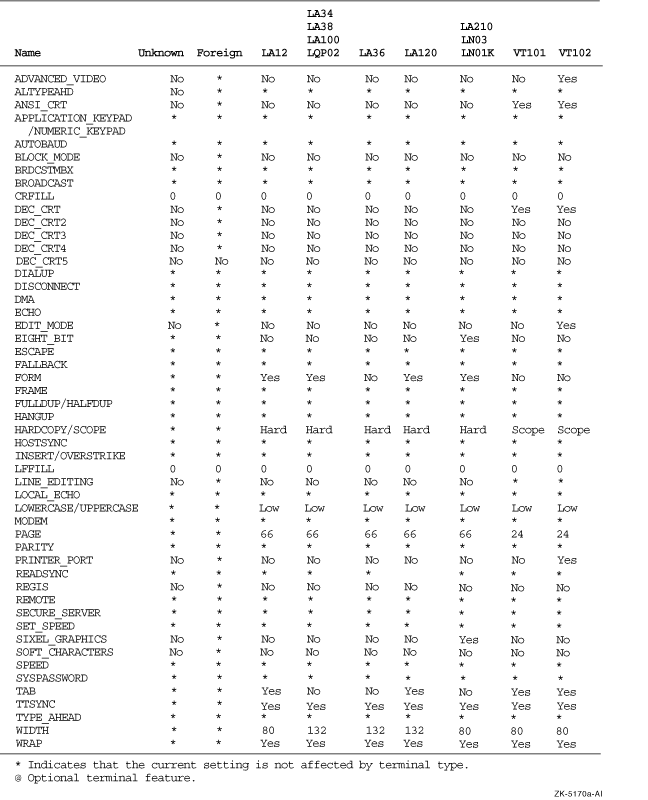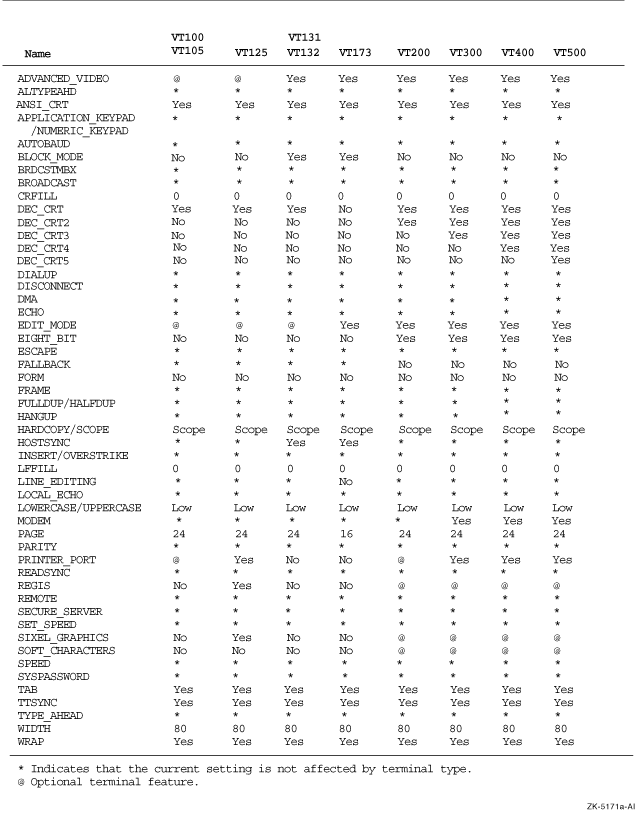Software > OpenVMS Systems > Documentation > 84final > 9996 HP OpenVMS Systems Documentation |
HP OpenVMS DCL Dictionary
SET TERMINAL
Sets the characteristics of a terminal. Entering a qualifier changes a characteristic; omitting a qualifier leaves the characteristic unchanged. FormatSET TERMINAL [device-name[:]] Parameter
DescriptionThe SET TERMINAL command modifies specific terminal characteristics for a particular application or overrides system default characteristics. (These defaults are defined at each installation, based on the most common type of terminal in use.) The default characteristics for terminals are listed in Figure DCLII-2. The table extends across two pages to document a range of terminals. 

Qualifiers
1This is the default characteristic set by the system and is not a valid qualifier for your use. The terminal types and characteristics that can be set are listed in Figure DCLII-2. /DIALUP/NODIALUP (default)Controls whether the terminal is a dialup terminal./DISCONNECT/NODISCONNECT (default)Controls whether the process connected to this terminal is disconnected if the line detects a hangup. The /DISCONNECT qualifier is valid only when the /PERMANENT qualifier is specified./DISMISS/NODISMISS (default)Controls whether the terminal driver ignores data that causes a parity error (instead of terminating the currently outstanding I/O with an error status)./DMA/NODMAControls whether direct memory access (DMA) mode is used on a controller that supports this feature./ECHO (default)/NOECHOControls whether the terminal displays the input it receives. With the /NOECHO qualifier, the terminal displays only system or user application output, or both./EDIT_MODE/NOEDIT_MODEControls whether the terminal can perform ANSI-defined advanced editing functions./EIGHT_BIT/NOEIGHT_BITControls whether the terminal uses the 8-bit ASCII protocol rather than the 7-bit ASCII protocol. You can use the Terminal Fallback Facility (TFF) to set the 8-bit characteristic on terminals. If the terminal you specify has the TFF enabled, the /EIGHT_BIT qualifier has no effect. For more information on terminal fallback, see the OpenVMS Terminal Fallback Utility Manual (available on the Documentation CD-ROM)./ESCAPE/NOESCAPE (default)Controls whether escape sequences are validated./FALLBACK/NOFALLBACKControls whether the 8-bit DEC Multinational character set characters are displayed on the terminal in their 7-bit representation. The default depends on the /EIGHTBIT setting of the terminal. If the OpenVMS Terminal Fallback Facility (TFF) is enabled, it activates the default character conversion tables for the named terminal. For more information, see the OpenVMS Terminal Fallback Utility Manual (available on the Documentation CD-ROM). If TFF is not enabled on your system, the /FALLBACK qualifier has no effect and no error message is displayed./FORM/NOFORMControls whether a form feed is transmitted rather than translated into multiple line feeds./FRAME=nSpecifies the number of data bits that the terminal driver expects for every character that is input or output. The value of n can be from 5 to 8. The default value depends on the settings for the terminal established by the /PARITY and /EIGHTBIT qualifiers./FULLDUP (default)/NOFULLDUPControls whether the terminal operates in full-duplex mode. The /FULLDUP qualifier is equivalent to the /NOHALFDUP qualifier./HALFDUP/NOHALFDUP (default)Controls whether the terminal operates in half-duplex mode. The /HALFDUP qualifier is equivalent to the /NOFULLDUP qualifier./HANGUP/NOHANGUP (default)May require LOG_IO (logical I/O) or PHY_IO (physical I/O) privilege depending on system generation parameter settings.Controls whether the terminal modem is hung up when you log out. /HARDCOPY/NOHARDCOPYControls whether the device is established as a hardcopy terminal and outputs a backslash (\) when the Delete key is pressed. The /HARDCOPY qualifier is equivalent to the /NOSCOPE qualifier./HOSTSYNC/NOHOSTSYNC (default)Controls whether system transmission from the terminal is stopped (by generating a Ctrl/S) when the input buffer is full and resumed (by generating a Ctrl/Q) when the input buffer is empty./INQUIRESets the device type when the /INQUIRE qualifier is specified and the DEC_CRT characteristic is set. The SET TERMINAL command reads the current screen size from the terminal and sets the corresponding page length and page width values appropriately. The default device type is UNKNOWN. Works only on DIGITAL terminals, and not on LA36 or VT05 terminals. Some VT100 family terminals, including the VT101 and VT105, return a VT100 type response. LA38 terminals respond as LA43 terminals.
You can include the SET TERMINAL/INQUIRE command in your LOGIN.COM file to detect the terminal type automatically. If you specify /INQUIRE=OLD, OpenVMS sets the terminal window to 24 lines by 80 columns and ignores the real terminal size. (This is the behavior of the SET TERMINAL/INQUIRE command prior to OpenVMS Version 6.2.)
/INSERTSets the terminal to insert mode. This feature allows you to insert characters when editing command lines. The default mode is overstrike, which allows you to type over the current character when editing a command line. Press Ctrl/A to switch from one mode to the other./LFFILL[=fill-count]Transmits to the terminal the specified number of null characters after each line feed before transmitting the next meaningful character (to ensure that the terminal is ready for reception). The value must be an integer in the range 0 to 9. The default is installation dependent. See Figure DCLII-2 for a list of default terminal characteristics./LINE_EDITING/NOLINE_EDITINGControls whether advanced line-editing features are enabled for editing command lines: pressing Return and pressing Ctrl/Z are recognized as line terminators, as are escape sequences./LOCAL_ECHO/NOLOCAL_ECHO (default)Controls whether the terminal echoes characters locally (rather than the host echoing them) for command level terminal functions. (Do not use the /LOCAL_ECHO qualifier with utilities that require control over echoing, such as line editing or EDT's screen mode.)
/LOWERCASE/NOLOWERCASEControls whether lowercase characters are passed to the terminal. The /NOLOWERCASE qualifier translates all input to uppercase. The /LOWERCASE qualifier is equivalent to the /NOUPPERCASE qualifier./MANUALIndicates manual switching of terminal lines to dynamic asynchronous DDCMP lines when your local terminal emulator does not support automatic switching. The /MANUAL qualifier should be specified with the /PROTOCOL=DDCMP and /SWITCH=DECNET qualifiers./MODEM/NOMODEMSpecifies whether the terminal is connected to a modem or a cable that supplies standard EIA modem control signals. If your terminal has the MODEM characteristic, entering SET TERMINAL/NOMODEM automatically logs you out. The /MODEM qualifier and the /COMMSYNC qualifier are mutually exclusive./NUMERIC_KEYPAD (default)Specifies whether the keys of the numeric keypad are used to type numbers and punctuation marks (/NUMERIC_KEYPAD) or to enter DCL commands defined with the DEFINE/KEY command (/APPLICATION_KEYPAD)./OVERSTRIKE (default)Sets the terminal to overstrike mode. This feature allows you to type over the current character when you are editing a command line. Set your terminal to insert mode if you want to insert characters when editing command lines. Press Ctrl/A to switch from one mode to the other./PAGE[=lines-per-page]Specifies the number of print lines between perforations for hardcopy terminals. (When the terminal reads a form feed, it advances the paper to the next perforation.) The value of the lines-per-page parameter can be from 0 to 255 and defaults to 0 (which treats a form feed as a line feed)./PARITY[=option]/NOPARITY (default)Controls whether the terminal passes data with only odd or even parity, where option equals ODD or EVEN. If you specify the /PARITY qualifier without an option, the value defaults to EVEN./PASTHRU/NOPASTHRU (default)Controls whether the terminal passes all data (including tabs, carriage returns, line feeds, and control characters) to an application program as binary data. The setting of /TTSYNC is allowed.Make sure that you spell both these qualifiers exactly as they appear in the text. /PERMANENTRequires LOG_IO (logical I/O) or PHY_IO (physical I/O) privilege.Sets characteristics on a permanent basis, that is, over terminal sessions; however, the characteristics revert to their initial values if the system is halted and restarted. Use in a system startup file to establish characteristics for all terminals on the system. /PRINTER_PORT/NOPRINTER_PORTSpecifies whether the terminal has a printer port (an attribute not set by the SET TERMINAL/INQUIRE command). The default is installation dependent. See Figure DCLII-2 for a list of default terminal characteristics./PROTOCOL=DDCMP/PROTOCOL=NONE (default)On VAX, controls whether the terminal port specified is changed into an asynchronous DDCMP line. The /PROTOCOL=NONE qualifier changes an asynchronous DDCMP line back into a terminal line. Note that /PROTOCOL=DDCMP is a permanent characteristic; therefore, the /PERMANENT qualifier is not required./READSYNC/NOREADSYNC (default)Controls whether the terminal uses the Ctrl/S and Ctrl/Q functions to synchronize data transmitted from the terminal.
The default is the /NOREADSYNC qualifier; the system does not use the Ctrl/S and Ctrl/Q functions to control reads to the terminal. The /READSYNC qualifier is useful for certain classes of terminals that demand synchronization or for special-purpose terminal lines where data synchronization is appropriate. /REGIS/NOREGISSpecifies whether the terminal understands ReGIS graphic commands./SCOPE/NOSCOPEControls whether the device is established as a video terminal. The /SCOPE qualifier is equivalent to the /NOHARDCOPY qualifier./SECURE_SERVER/NOSECURE_SERVER (default)Requires either LOG_IO (logical I/O) or PHY_IO (physical I/O) privilege.Controls whether the Break key on the terminal logs out the current process (except on a virtual terminal). With the /SECURE_SERVER qualifier in effect, pressing the Break key when there is no current process initiates the login sequence. With the /NOSECURE_SERVER qualifier in effect, the break is ignored. On terminals with the AUTOBAUD and SECURE_SERVER characteristics, pressing the Break key disconnects the current process, but is not required to start a new login sequence. However, when the NOAUTOBAUD characteristic is set, the SECURE_SERVER characteristic requires a break to initiate a new login sequence. /SET_SPEED/NOSET_SPEEDRequires either LOG_IO (logical I/O) or PHY_IO (physical I/O) privilege.Controls whether the /SPEED qualifier can be used to change the terminal speed. /SIXEL_GRAPHICS/NOSIXEL_GRAPHICSSpecifies whether the terminal is capable of displaying graphics using the sixel graphics protocol. The default is device dependent. For a list of default terminal characteristics, see Figure DCLII-2./SOFT_CHARACTERS/NOSOFT_CHARACTERSSpecifies whether the terminal is capable of loading a user-defined character set. The default is device dependent. See Figure DCLII-2 for a list of default terminal characteristics./SPEED=(input-rate,output-rate)Sets the baud rate at which the terminal receives and transmits data. If the input and output rates are the same, specify /SPEED=rate.Not all terminals support different input and output baud rates. For specific information on baud rates for your terminal, consult the manual for that terminal. The default transmission rates are installation dependent. The valid values for input and output baud rates are as follows:
/SWITCH=DECNETOn VAX, causes the terminal lines at each node to be switched to dynamic asynchronous DDCMP lines, when specified with the /PROTOCOL=DDCMP qualifier. Note that /SWITCH=DECNET is a permanent characteristic; therefore, the /PERMANENT qualifier is not required./SYSPASSWORD/NOSYSPASSWORD (default)Requires LOG_IO (logical I/O) privilege.Determines whether the terminal requires that a system password be entered before the Username: prompt. /TAB/NOTABControls whether tab characters are converted to multiple blanks. The /NOTAB qualifier expands all tab characters to blanks and assumes tab stops at 8-character intervals. The default is device dependent. For a list of default terminal characteristics, see Figure DCLII-2./TTSYNC (default)/NOTTSYNCControls whether transmitting to the terminal is stopped when Ctrl/S is pressed and resumes transmission when Ctrl/Q is pressed./TYPE_AHEAD (default)/NOTYPE_AHEADControls whether the terminal accepts unsolicited input to the limit of the type-ahead buffer.When you specify the /NOTYPE_AHEAD qualifier, the terminal accepts input only when a program or the system issues a read to the terminal, such as for user input at the DCL prompt ($). When you specify the /TYPE_AHEAD qualifier, the amount of data that can be accepted is governed by the size of the type-ahead buffer. That size is determined by system generation parameters. /UNKNOWNSpecifies a terminal type that is unknown to the system, which then uses the default terminal characteristics for unknown terminals. For a summary of the settings, see Figure DCLII-2./UPPERCASE/NOUPPERCASEControls whether lowercase characters are translated to uppercase. The /UPPERCASE qualifier is equivalent to the /NOLOWERCASE qualifier./WIDTH=characters-per-lineSpecifies the maximum characters per line. This value must be an integer in the range 1 to 511. With the /WRAP qualifier, the terminal generates a carriage return and line feed when the width specification is reached.If the specified width on an ANSI terminal is 132, the screen is set to 132-character mode. If the terminal does not have advanced video option (AVO), the page length limit is set to 14 lines. /WRAP (default)/NOWRAPControls whether a carriage return and line feed are generated when the value of the /WIDTH qualifier is reached.Examples
|